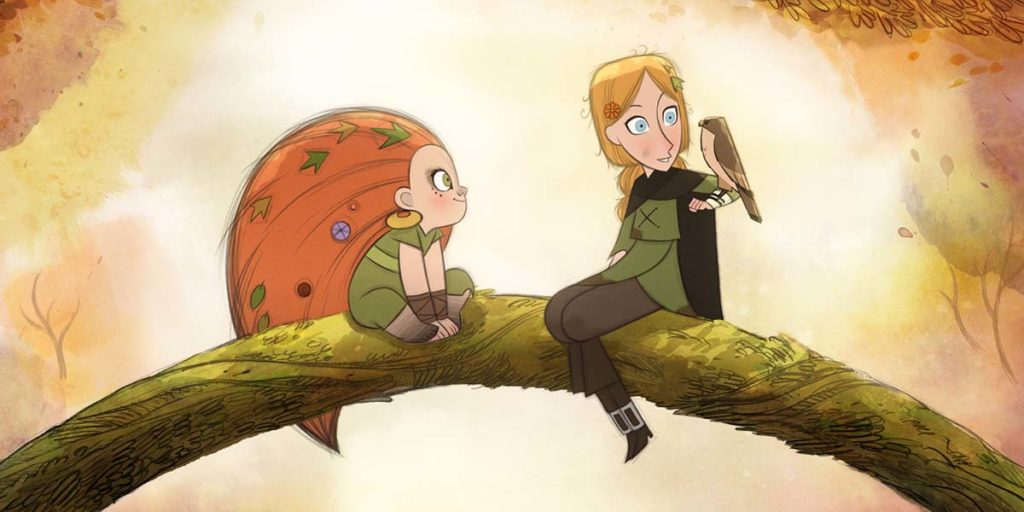Wolfwalkers

Image courtesy TIFF.
Tomm Moore, director of THE SECRET OF KELLS (co-produced with Nora Twomey whose THE BREADWINNER premiered at Toronto International Film Festival in 2017), returns to the festival circuit with WOLFWALKERS. Co-directed with Ross Stewart (art director on KELLS) and written by Will Collins, the traditionally-animated feature tells the story of Robyn Goodfellowe (Honor Kneafsey) and her father Bill (Sean Bean), a hunter in the service of the Lord Protector Cromwell (Simon McBurney).
Situated on the edge of a forest, the town of Kilkenny, Ireland, poses a threat to an enchanted pack of wolves led by mother and daughter, Moll (Maria Doyle Kennedy) and Mebh (Eva Whittaker), a pair of “wolf wakers”. Though wolves by night and humans by day, I hesitate to refer to these enchanted beings as “werewolves”. For all intents and purposes they’re not anthropomorphized canines. They belong to a pack whose life-force intertwines with theirs. While on the surface the story bears considerable resemblance to Disney’s BRAVE, the latter places emphasis on humans as the status quo. Here, humans are the intruders.
Robyn’s father fears for her safety. Children aren’t permitted beyond the wall. We’re told the wolves are dangerous, though—our instincts tell us—not nearly as much as Cromwell. As it turns out, Mebh and her pack mates are mischievous, funny, good-natured, and fiercely protective of their habitat. When an arrow downs Robyn’s falcon, Merlin, Mebh uses her powers to save him. Unlike so many recycled Disney plots, the protagonist’s transformation here is accidental, but also a gift rather than a curse. WOLFWALKERS teaches strong lessons about the irrationality of fear, the virtue of cooperation, and the value of coexistence.
Though some of the plot relies on misunderstandings or miscommunications, what’s refreshing is the kinship that quickly forms between the two young girls. Children are fairly resilient and adaptive to new situations, naturally it follows these two aren’t bogged down by misunderstandings (not for long, anyway) as are father and daughter. Mebh calls her new friend, “Townie,” as she teaches her the way of the pack.
Like SECRET OF KELLS, the watercolor visuals of WOLFWALKERS accentuates the two worlds: The Lord Protector uses fire and cannons to try to tame the wolves. In contrast to the swaddling embrace and flowing lines of the forest, the incendiary, urban palette bursts with angular, harsh lines, and rough textures.
Earlier in the picture, the flat animation technique employed crowds the frame in two ways: civilization is patriarchal, cluttered by humans and tools of destruction; nature is matriarchal, teeming with plant and animal life. With the repetitious, clockwork motion of a factory, servants galore prepare a feast for the Lord Protector. Our mind draws the connection between the stirring ladles and swinging hatchets that take down the forest to support the runaway growth of 17th century England during the Protectorate, just before the formation of the Commonwealth of England. Though it’s never explicitly stated, the movie references the Cromwells’ brutality toward the Irish. From the wolves’ vantage point, the city—with its squared perimeter wall—resembles a cage. Following the Irish Rebellion and Eleven Years War, England enslaved the Irish. This period, from 1649 to 1653, is known as the Cromwellian Conquest of Ireland.
Reading between the jagged lines, there’s a subtle commentary on religious fanaticism—monotheism (fire rules all) vs. pantheism (harmony with ecology), or intensive agriculture vs. tribalism. To the wolves, the human world is smelly, putrid, foretelling of our legacy of trapping ourselves in a never-ending cycle of overconsumption which necessitates perpetual territorial expansion. Apropos, the moral of the story comes down to one exchange:
“I’m afraid,” says Bill. “Afraid that I won’t always be here to protect you. That one day you’ll end up in a cage.”
Robyn replies, “But I already am in a cage.”
WOLFWALKERS premieres at the 45th Toronto International Film Festival.